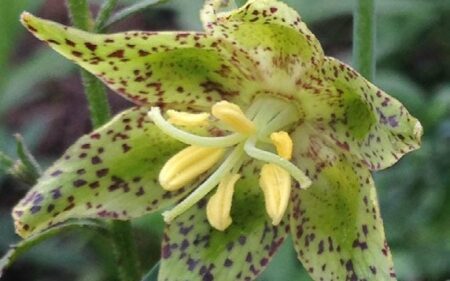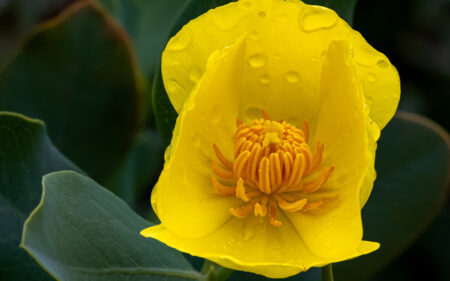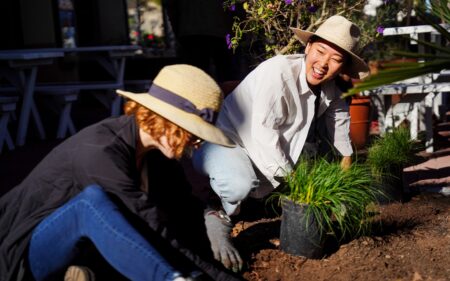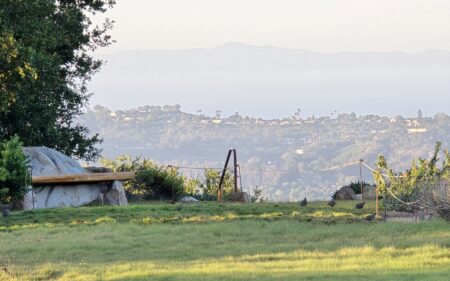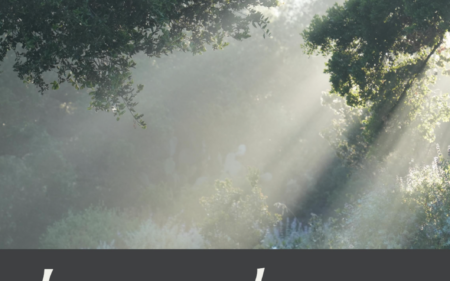Rare Lichens in California
California is home to over 2000 species of lichens, but only 15 are considered rare or endangered by the state. This tiny percentage (0.73%) gives the false impression that the remaining 99.27% of California lichens are more common. In reality, we don’t know enough about the vast majority of our lichens to determine whether they are rare, endangered, or common. The California Lichen Society (CALS) works with the California Native Plant Society to add more lichens to the rare and endangered list. Some California lichens are listed on the International Union for Conservation of Nature (IUCN) red list, but being on this red list does not by itself afford protection by state or federal entities. The information below is gleaned from CALS rare lichen sponsorships and IUCN red lists. More information can be found by clicking on the “CALS” and/or “IUCN” links for each species.
15 Rare California Lichens
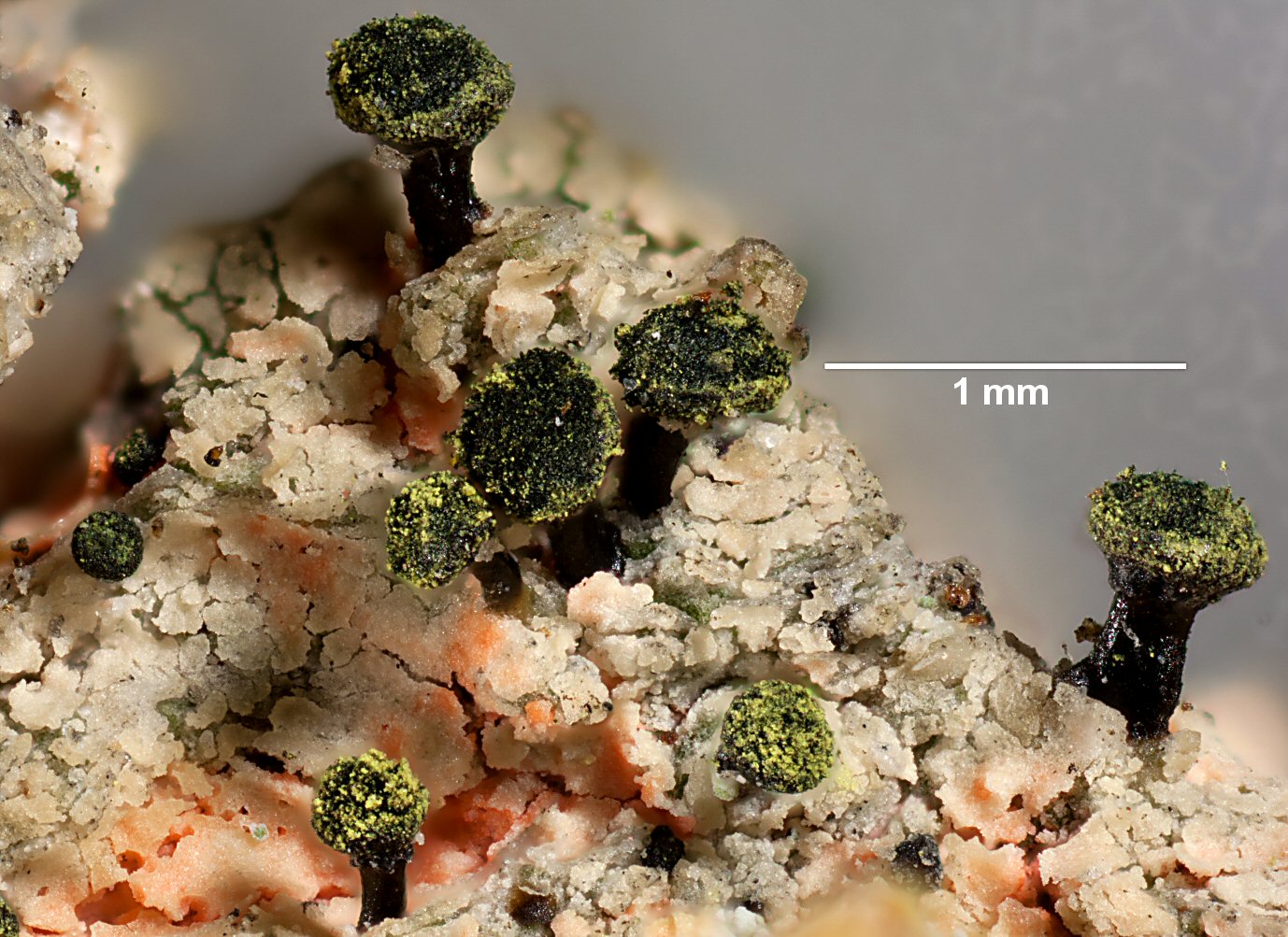
Spiral-Spored guilded-head pin lichen (Calicium adspersum)
Has a crazy common name and resembles a miniature patch of dirty snow supporting a grove of dressmaker’s pins. This species appears to be restricted to the bark of old-growth conifers. In North America, it is found from British Columbia to California with only one known locality in the northern-most part of the state. Logging and wildfires are the main threats to this species. Photo: Ulrich Kirschbaum. (CALS).
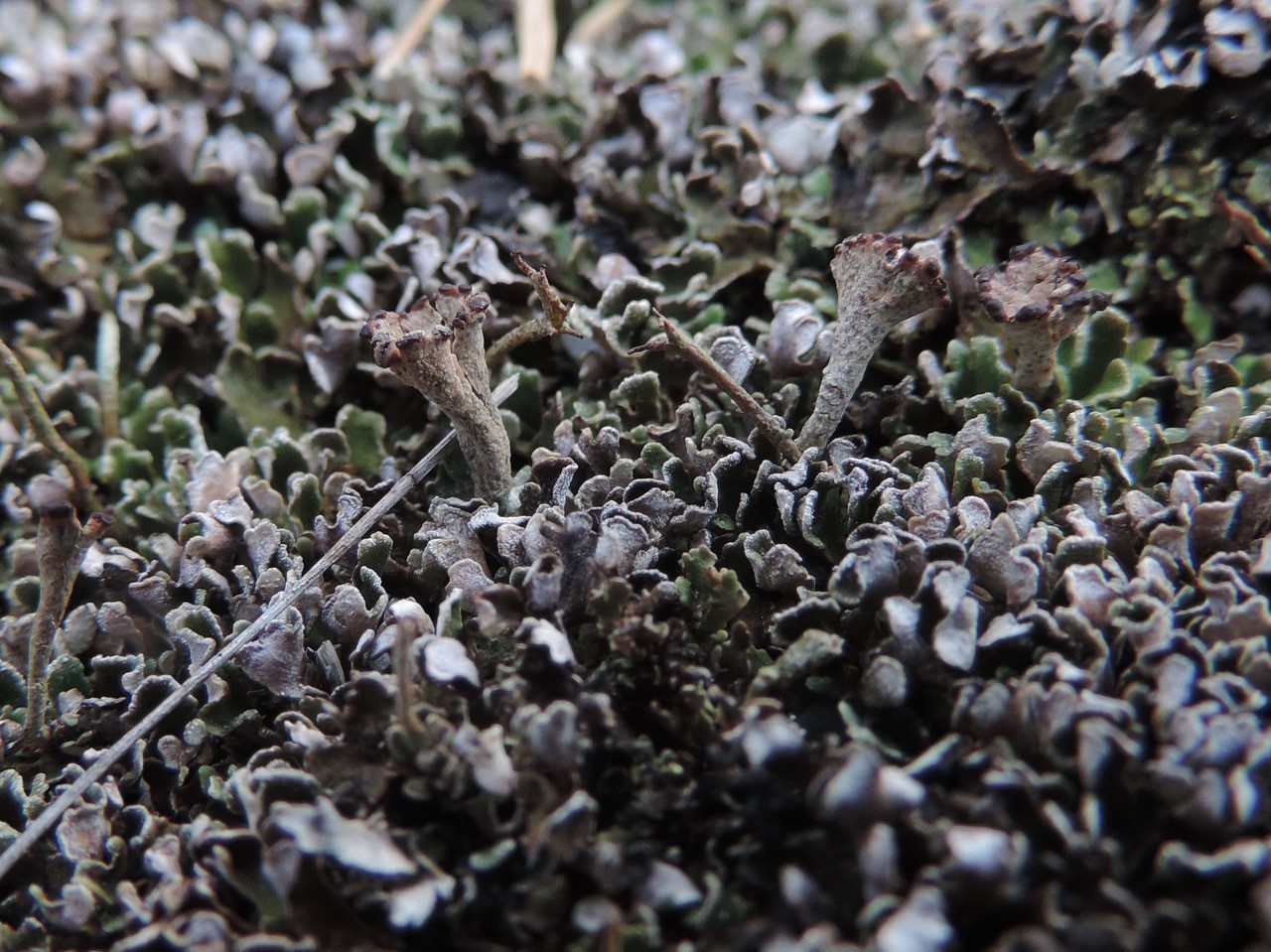
Popcorn lichen (Cladonia firma)
Belongs to the same genus of lichens as pixie cups and British soldiers. It grows on soil, and it is known from Europe, and oddly, four localities in California. Although it shares a common name with coastal popcorn lichen (Mobergia calculiformis; see below), these two lichens are not related. The species is threatened by urban development and recreational activities such as off-road driving and mountain biking. Photo: Neil Sanderson. (CALS).
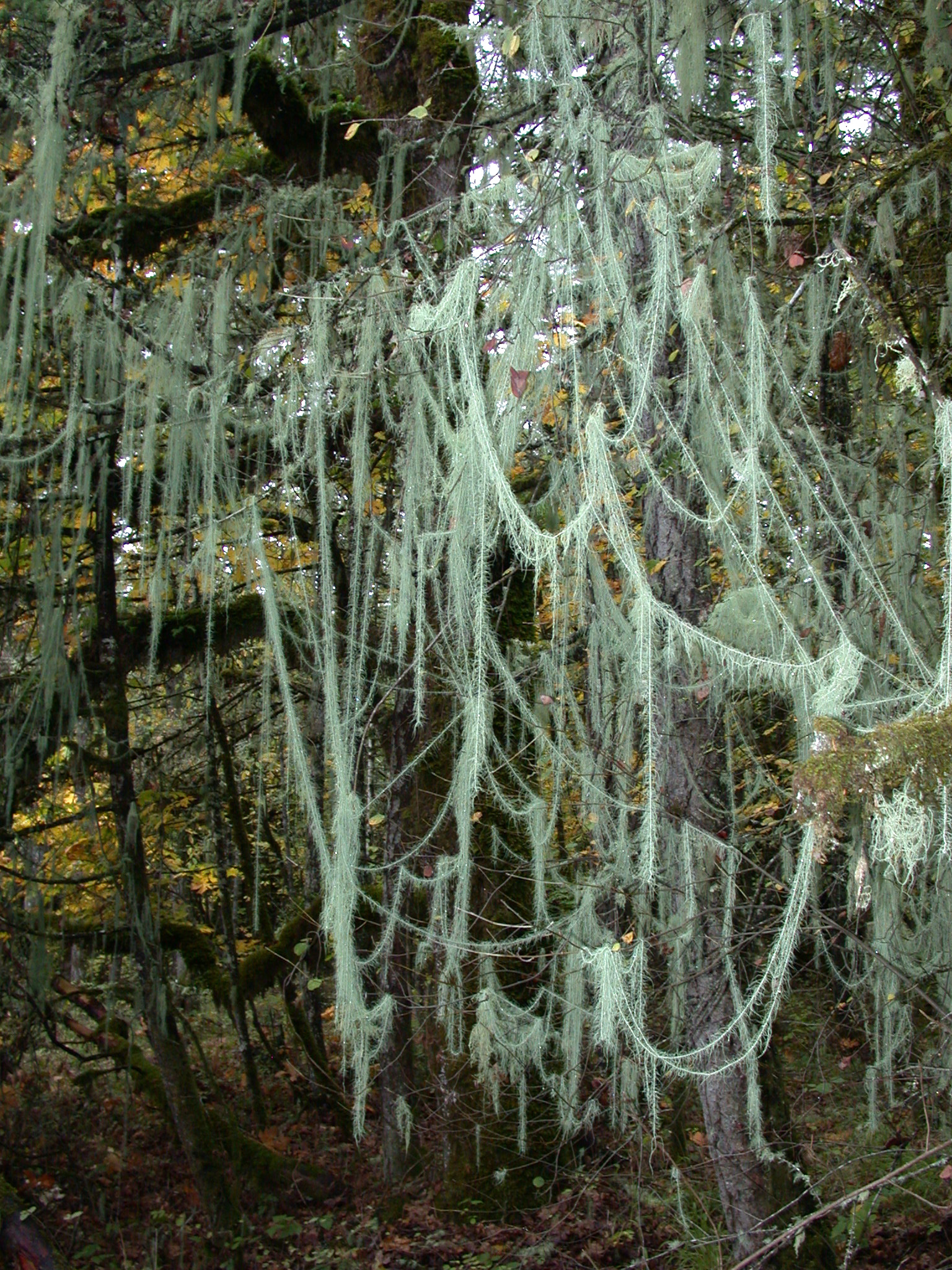
Old-man’s beard / Methuselah’s beard (Dolichousnea longissima)
Consists of many single strands that can exceed 10 ft in length. It commonly adorns branches and was likely the inspiration for tinsel on Christmas trees. In California it hugs the north coast, with occasional strands found in Marin and Sonoma counties. It is threatened by wildfire, logging, and collection for decorations. Don’t confuse it with lace lichen (Ramalina menziesii) which also adorns tree branches. Unlike old-man’s beard, lace lichen forms tiny nets and occurs all the way down to the southern tip of Baja California. Photo: Bruce McCune. (CALS).
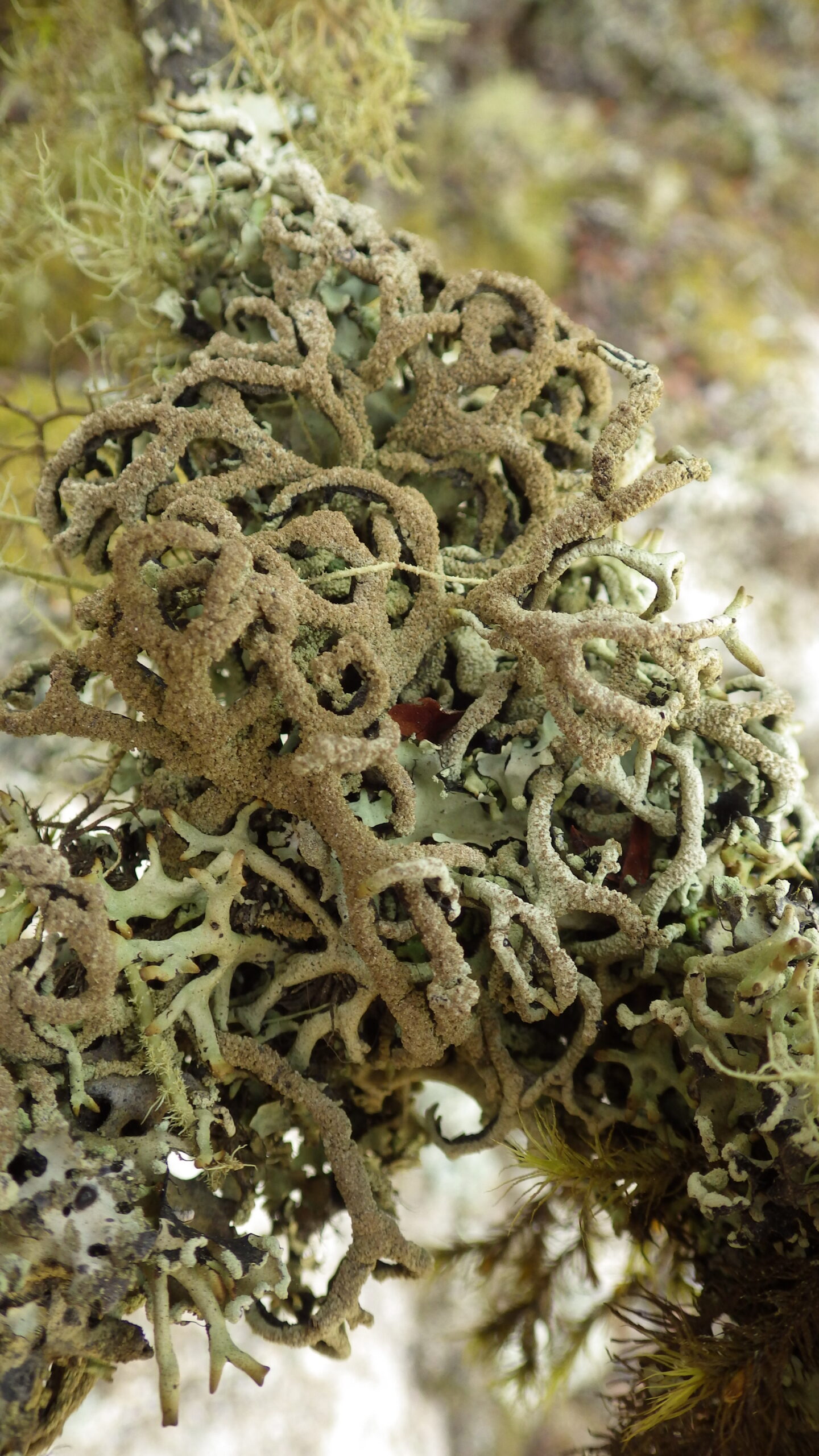
Island tube lichen (Hypogymnia schizidiata)
is characterized by having schizidia, which are flakes forming along cracks in its upper surface. It grows on bark and wood of both hardwood trees and conifers. The species was originally found on the islands off the coast of Mexico and two of the northern Channel Islands, but additional populations have since been found in San Mateo and Mendocino counties. The island populations are presumably relatively secure, whereas the mainland populations are threatened by wildfire. Photo: Rikke Reese Næsborg. (CALS).
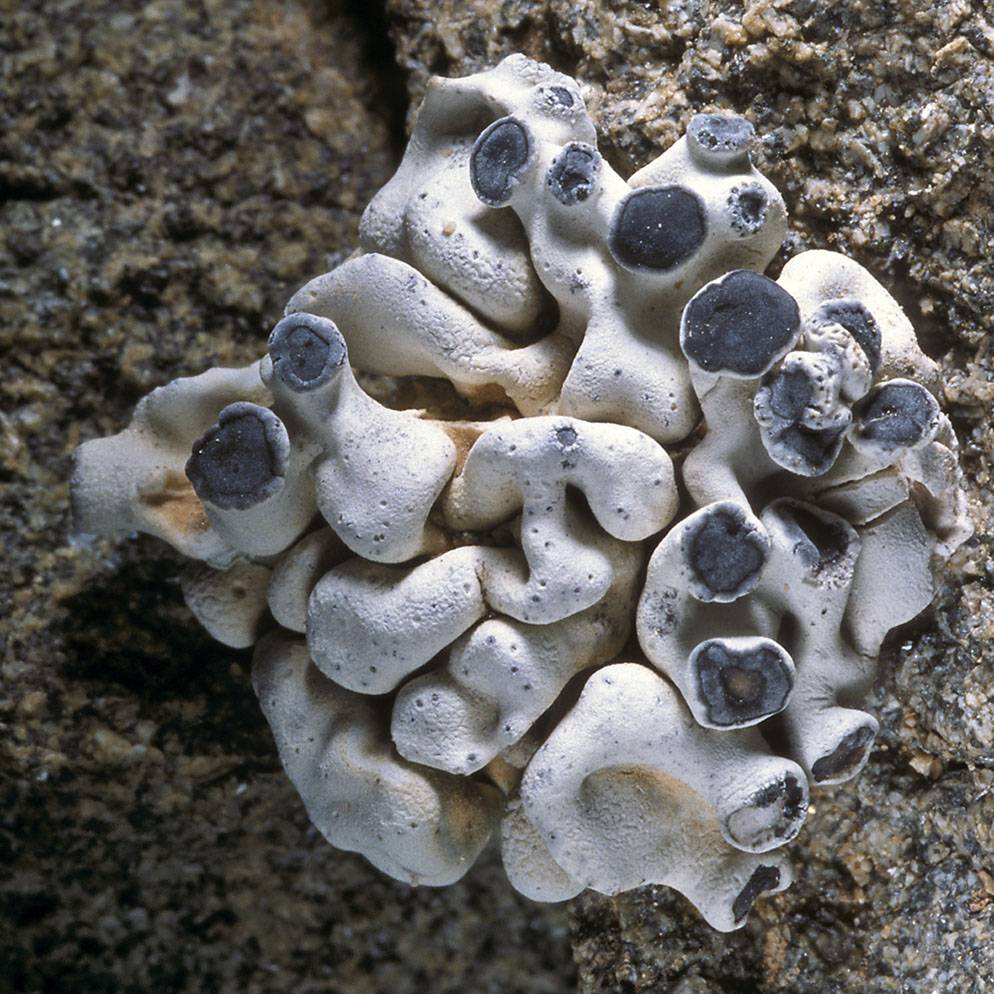
Coastal popcorn lichen (Mobergia calculiformis)
grows on rocks near the Pacific coast. It used to occur in southern California, where unfortunately, it may have been extirpated by urban and agricultural development. While no known populations remain in California, the species is still present in Mexico. Despite sharing a common name with popcorn lichen (Cladonia firma; see above), the two species are unrelated. Coastal popcorn lichen is IUCN red-listed as endangered. Photo: Frank Bungartz. (CALS) (IUCN).
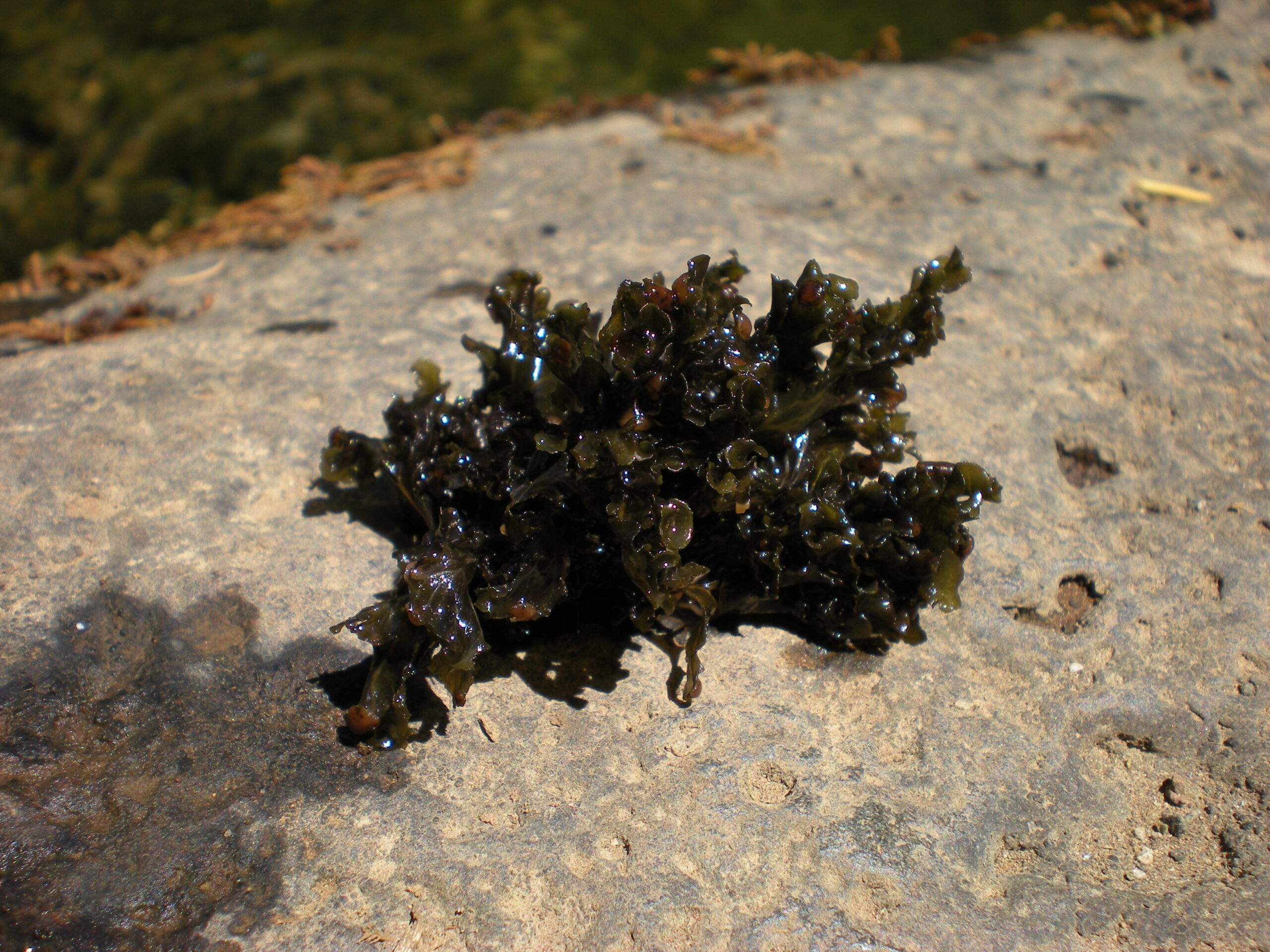
Trevor’s waterfan / western waterfan (Peltigera gowardii)
has the unusual habit of growing submerged in cool, clean mountain streams where it occurs on rock. As many lichens are good indicators of air quality, western waterfan is a good indicator of water quality. Any action that alters the quality of mountain streams is a threat to this lichen. Photo: Rikke Reese Næsborg. (CALS).
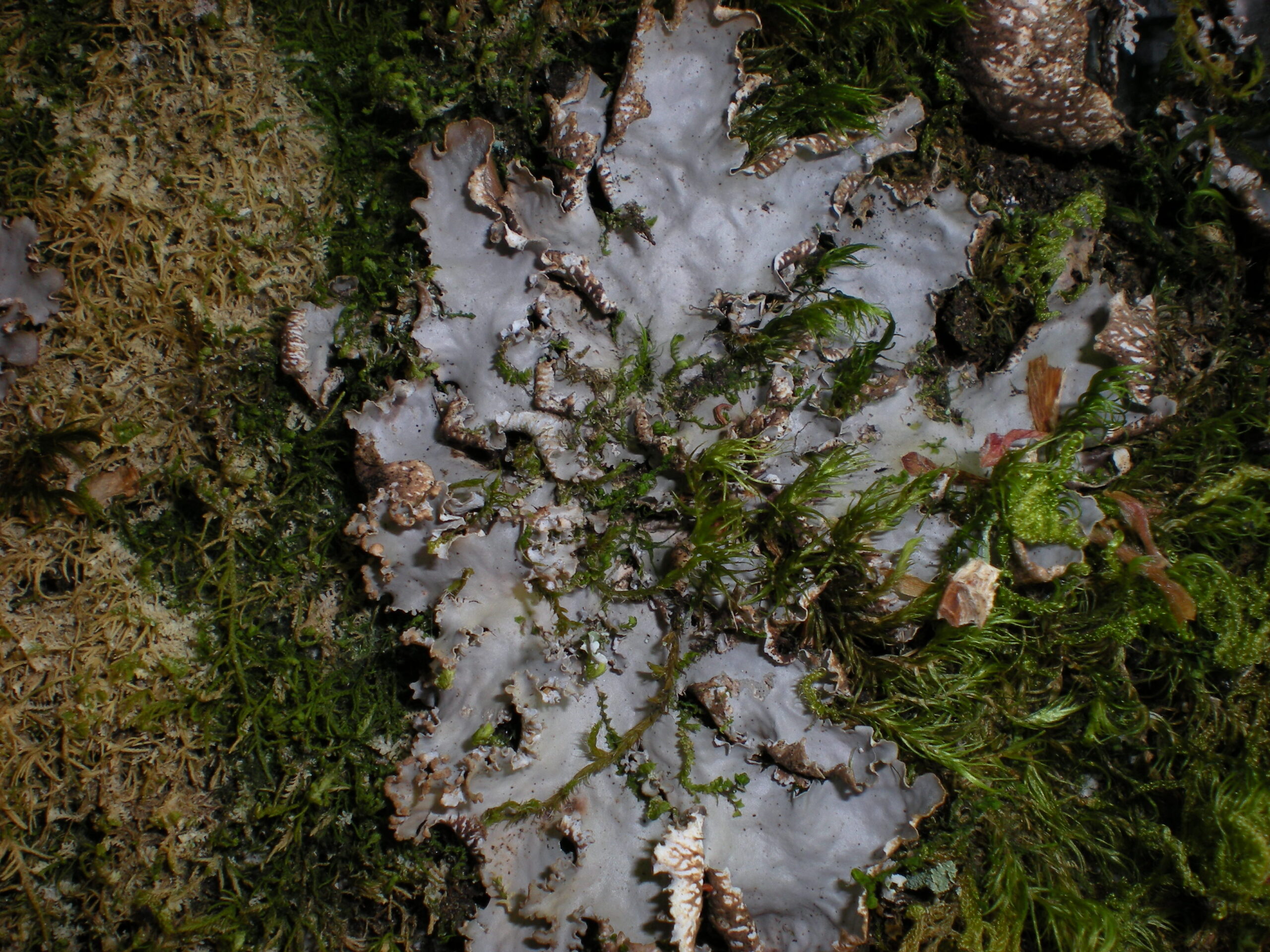
Fringed pelt / pacific pelt lichen (Peltigera pacifica)
grows on moss-covered soil, rocks, and tree bases. It prefers moist forests and has only been found in two localities in northernmost California. Recreational activities and wildfires are the major threats. Photo: Rikke Reese Næsborg. (CALS).
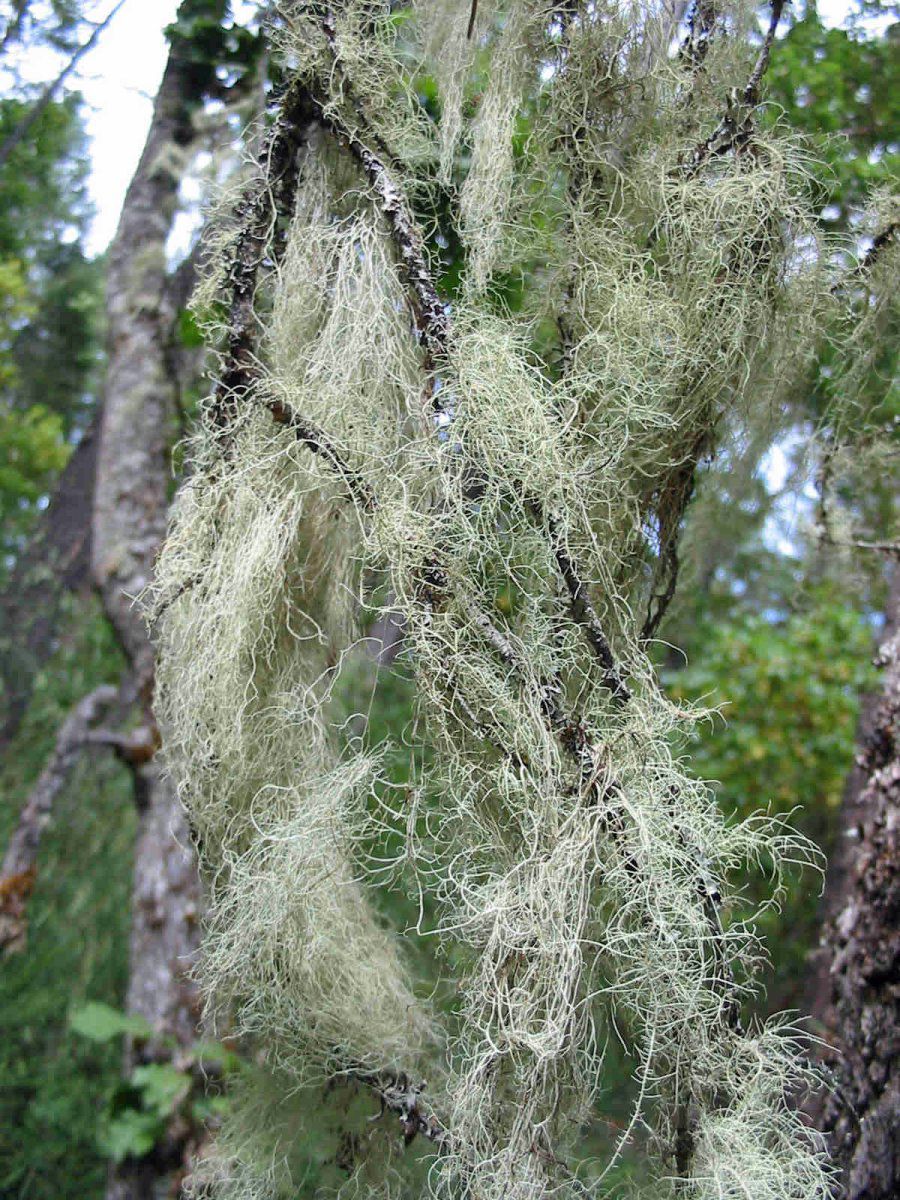
Angel’s hair (Ramalina thrausta)
is characterized by hair-like branches with curled tips—just like angel hair. It favors cool, moist, old-growth forests where it grows on bark. Angel’s hair in California is almost exclusively found in Del Norte County, but one isolated population exists in Sonoma County. This lichen is very sensitive to air pollution. Photo: Scot Loring. (CALS).
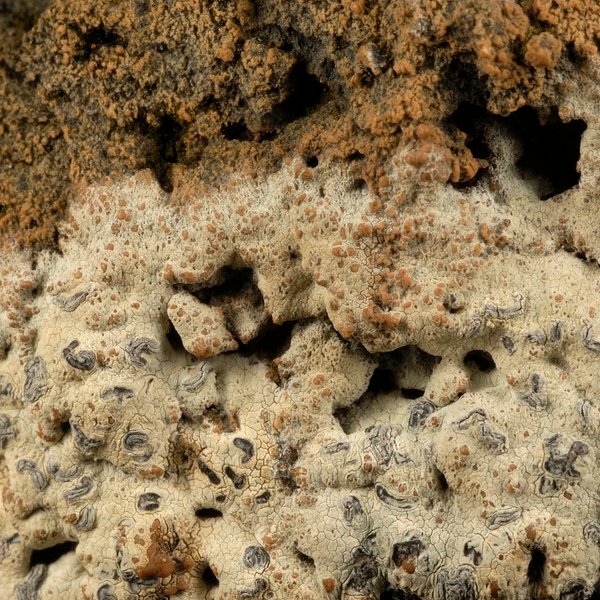
Rock script (Redonographa saxorum)
grows on moderately shaded north-facing volcanic rocks in coastal areas. Very little information is available for this species. It is known from just two localities on Santa Catalina Island and from Baja California. Photo: Frank Bungartz. (CALS).
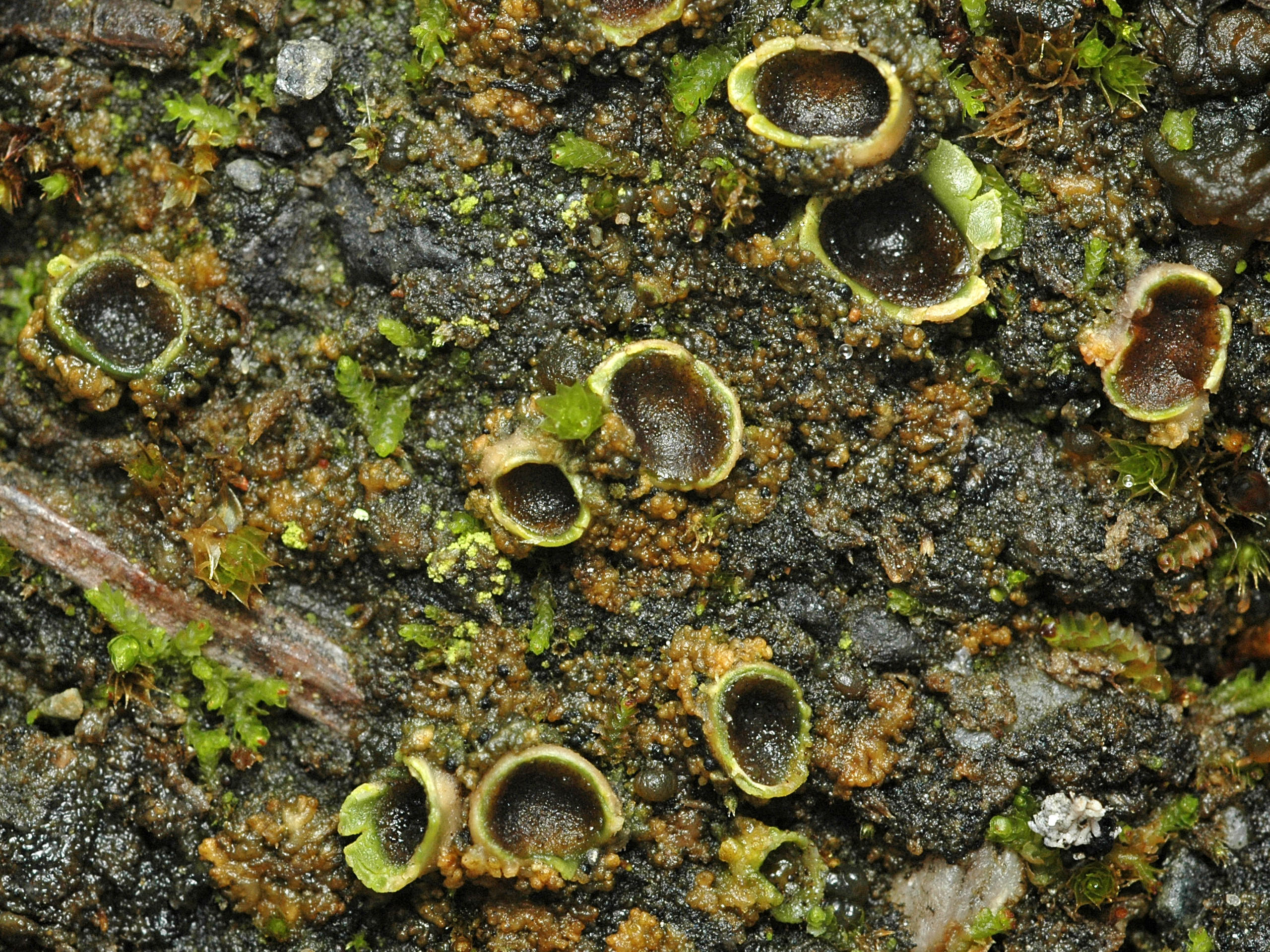
Fringed chocolate chip lichen (Solorina spongiosa)
Received its delicious common name because the fruiting bodies (apothecia) almost look like chocolate chips. The species is found in seeps over mossy, calcium-rich soil in cool alpine and sub-alpine areas. It is known in California from a few localities in the Sierra Nevada Mountains, one locality in the San Gorgonio Wilderness in the south, and one locality in the marble Mountain Wilderness in the north. The greatest threats to this species are trampling by livestock and people, as well as a warming and drying climate. Photo: Leif Stridvall. (CALS).
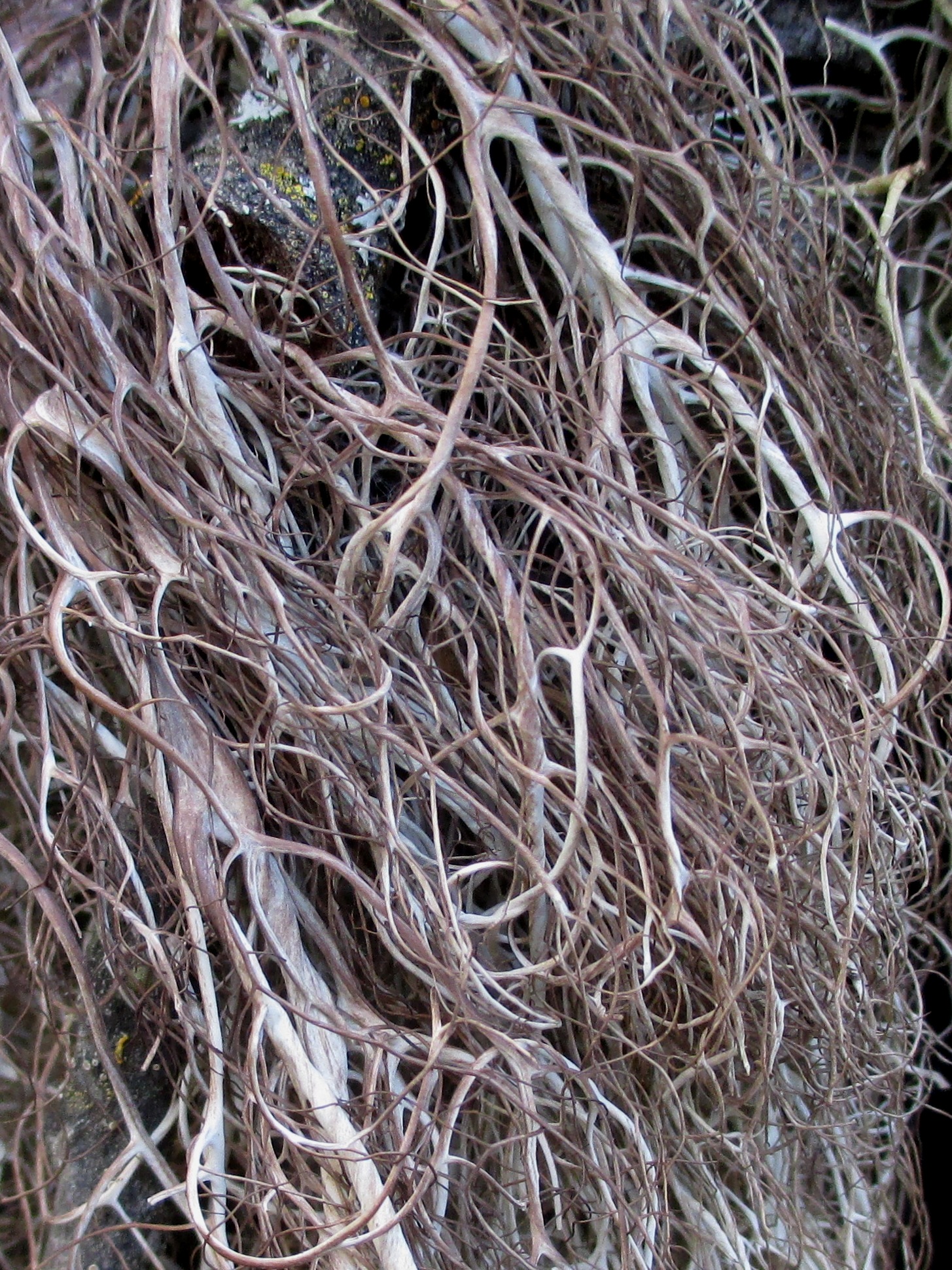
Groovy beard lichen (Sulcaria badia)
is a fruticose lichen with long, drooping branches. It grows on tree bark in well-lighted forests relatively close to the coast. The six known localities in California are found in the northern part of the state. The primary threats include residential development, the associated reduction in air quality, and wildfire. It is listed on the IUCN red list as endangered. Photo: Troy McMullin. (CALS) (IUCN).
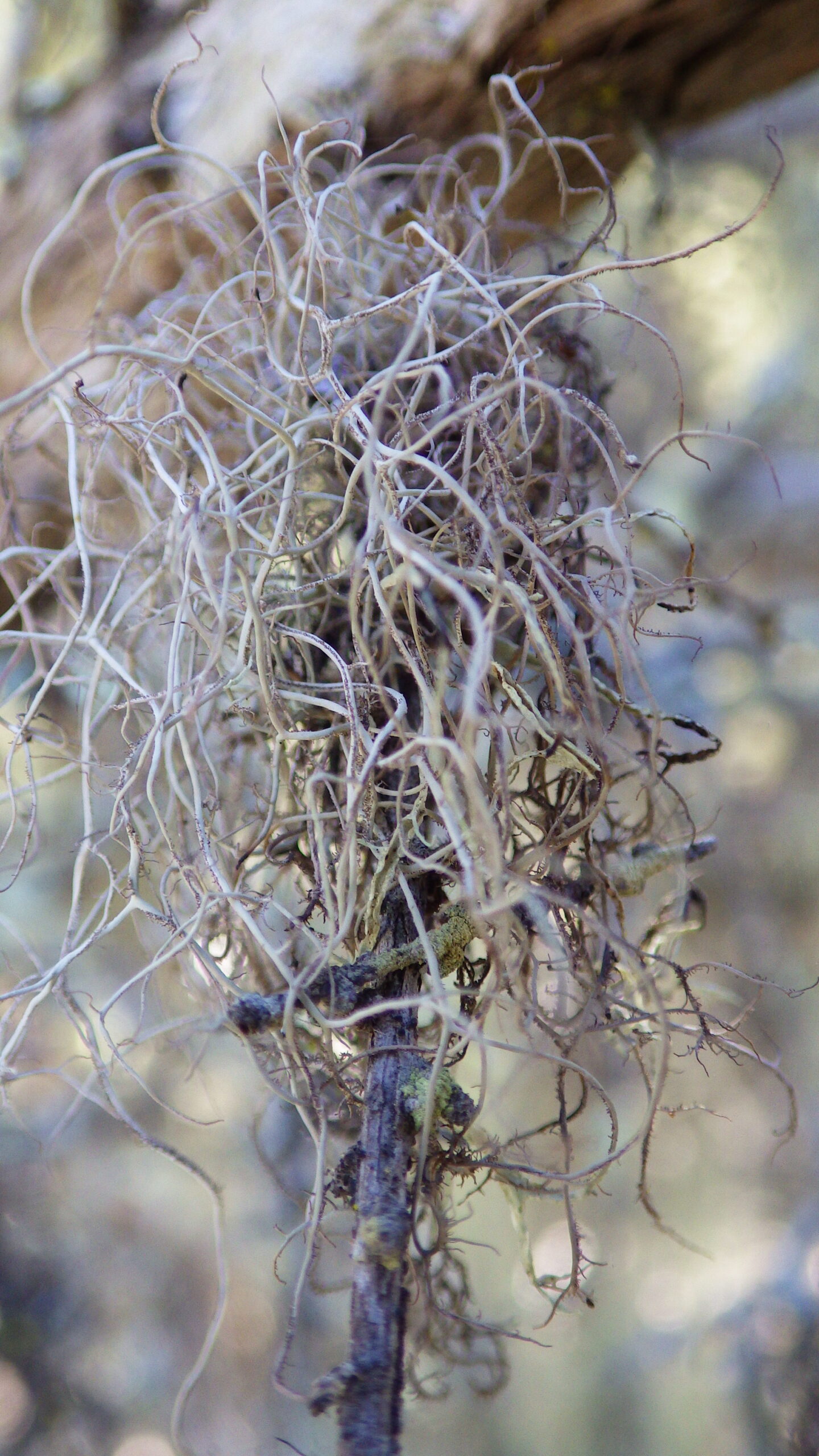
Splitting yarn lichen (Sulcaria isidiifera)
Like it’s sister to the left, is also a fruticose lichen with drooping branches, although usually much smaller than groovy beard lichen. The main difference is that splitting yarn lichen has slits along its branches with tiny finger-like parts (isidia) emerging from the slits. The species is restricted to old-growth coastal chaparral in San Luis Obispo County. It is mainly threatened by urban development and wildfires. A former Garden herbarium technician, Eli Balderas, is currently studying this species for his Master’s degree. The species is listed as critically endangered on the IUCN red list. Photo: Rikke Reese Næsborg. (CALS) (IUCN).
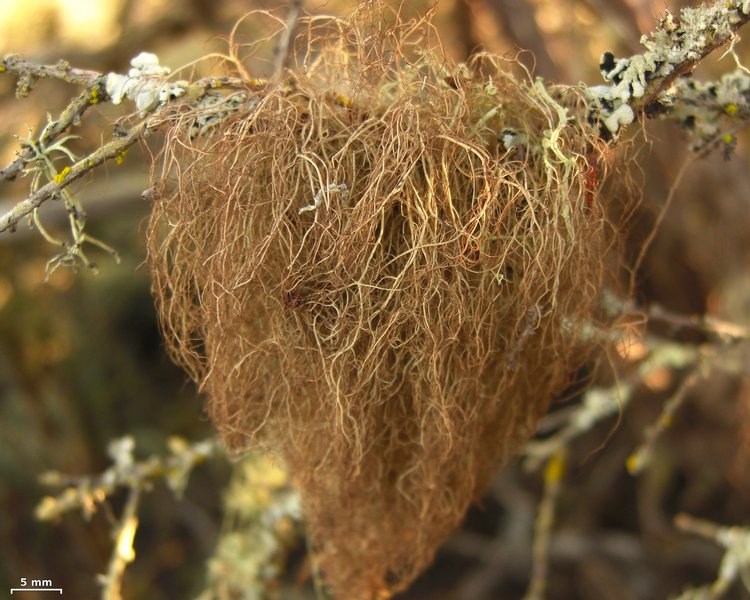
Twisted horsehair lichen (Sulcaria spiralifera)
is another fruticose, hair-like lichen that has tiny splits spiraling around its branches. It mainly grows on conifers occupying the immediate coast. Populations of the species have been found in Humboldt, Sonoma, Monterey, and San Luis Obispo counties. Coastal development and climate change are the main threats. The species is listed as endangered on the IUCN red list. Photo: Jason Hollinger. (CALS) (IUCN).
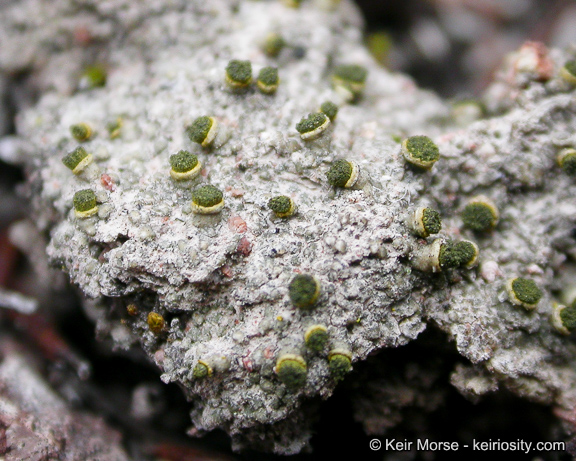
Woven-spored lichen (Texosporium sancti-jacobi)
grows directly on soil and animal pellets. It is usually part of biological soil crust communities. In arid and semi-arid regions, soil crust communities serve the extremely important role of controlling soil erosion, increasing water retention, and moderating soil temperature. The species has been found in arid intermountain areas from Monterey to San Diego counties. Major threats include trampling, urban and agricultural development, invasive species, and wildfire. It is listed as endangered on the IUCN red list. Photo: Keir Morse. (CALS) (IUCN).
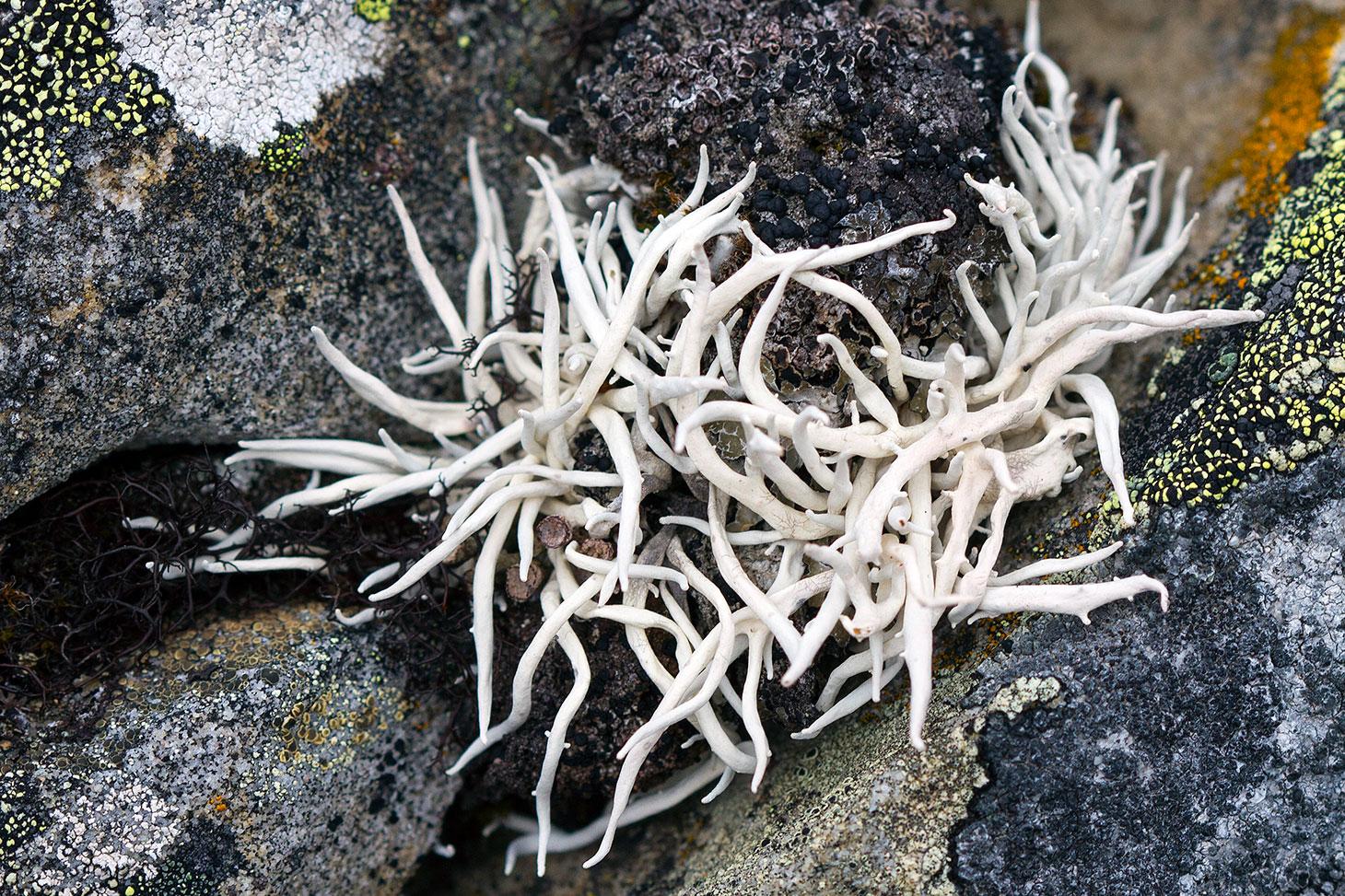
Whiteworm lichen (Thamnolia vermicularis)
looks like a bunch of white worms wriggling out of the ground. Although mainly preferring arctic-alpine habitats, the species is known from two localities in Marin county. Trampling by livestock, vehicles, and people are the main threats. Photo: Samuel Brinker. (CALS).
The following two lichens haven’t quite made it to the California rare species list yet, but they will probably be added before the end of 2022.
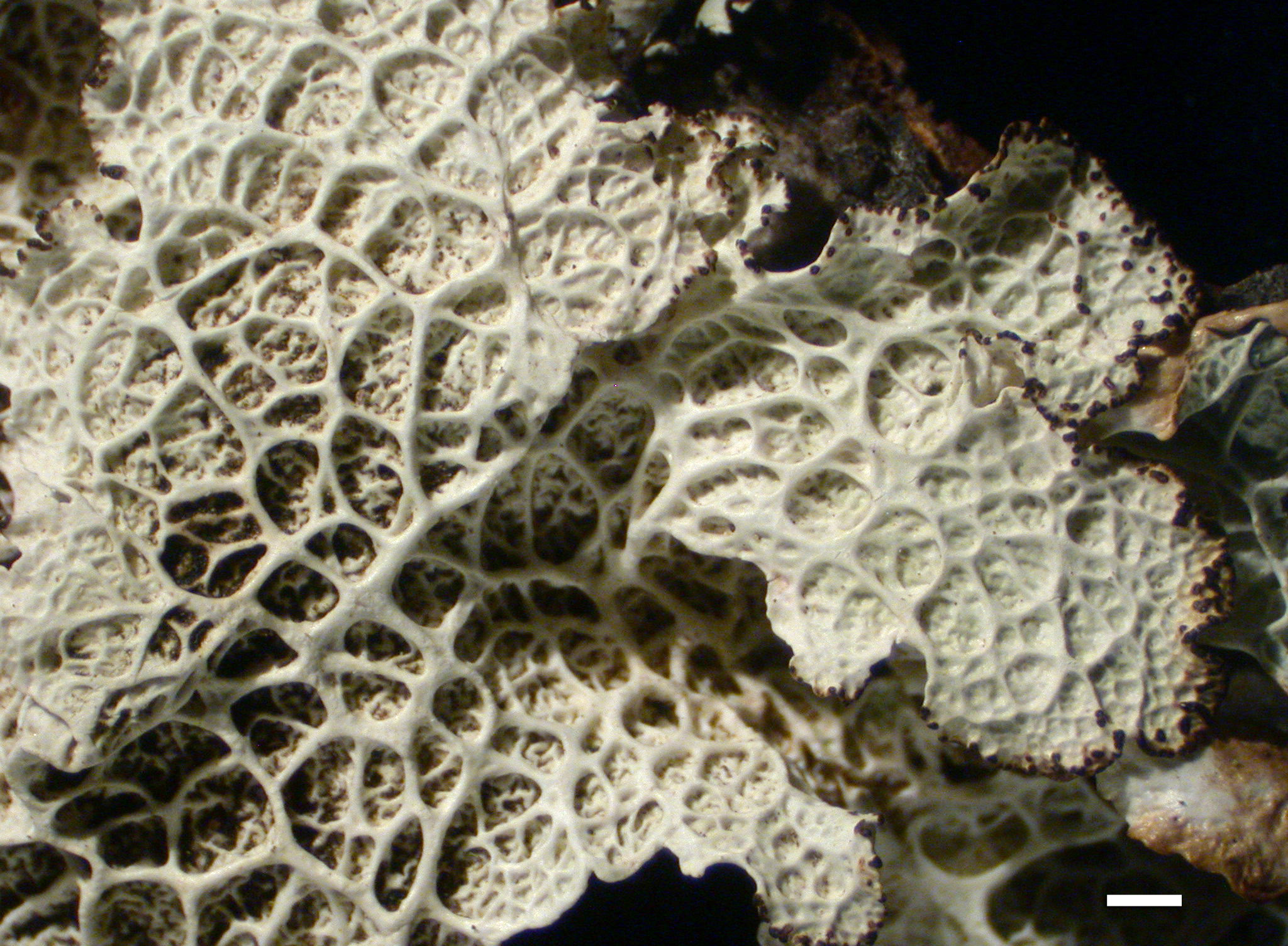
Crinkled rag lichen (Platismatia lacunosa)
resembles a bleached piece of crinkled lettuce. It can grow on both hardwood and conifer bark, but seems to prefer alder (Alnus spp.). The species prefers moist, riparian forests and occurs in four locations in northern-most California. Although crinkled rag lichen is threatened by air pollution and sea level rise which may decrease the number of suitable habitats, the biggest threat is removal of trees. Photo: Bruce McCune.
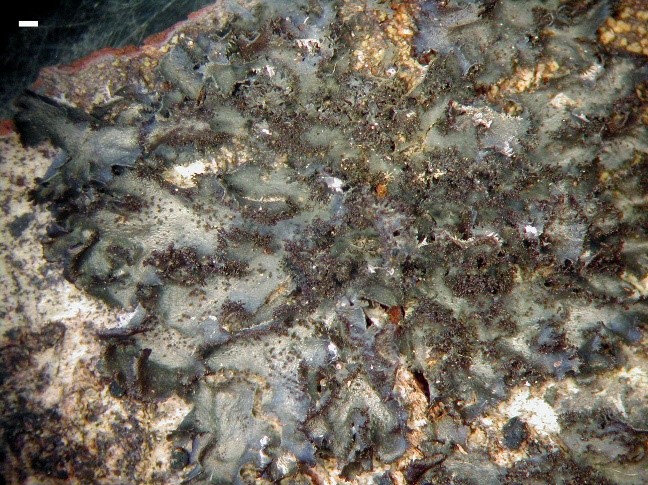
Siskiyou jellyskin lichen (Scytinium siskiyouense)
is a so-called jelly-lichen because it appears gelatinous when wet. Unlike most jelly-lichens, this one has tiny, finger-like protrusions (isidia) fringing the margins, and tufts of hair on the lower surface. It grows on hardwood trees in mixed hardwood/conifer forests. The majority of the California locations are in Trinity County where wildfires have reduced the species by at least 27% since 2015. Wildfire remains the major threat to the remaining populations. Photo: Daphne Stone.
The following lichens are only listed on the IUCN red list, and therefore do not currently enjoy protection in California.
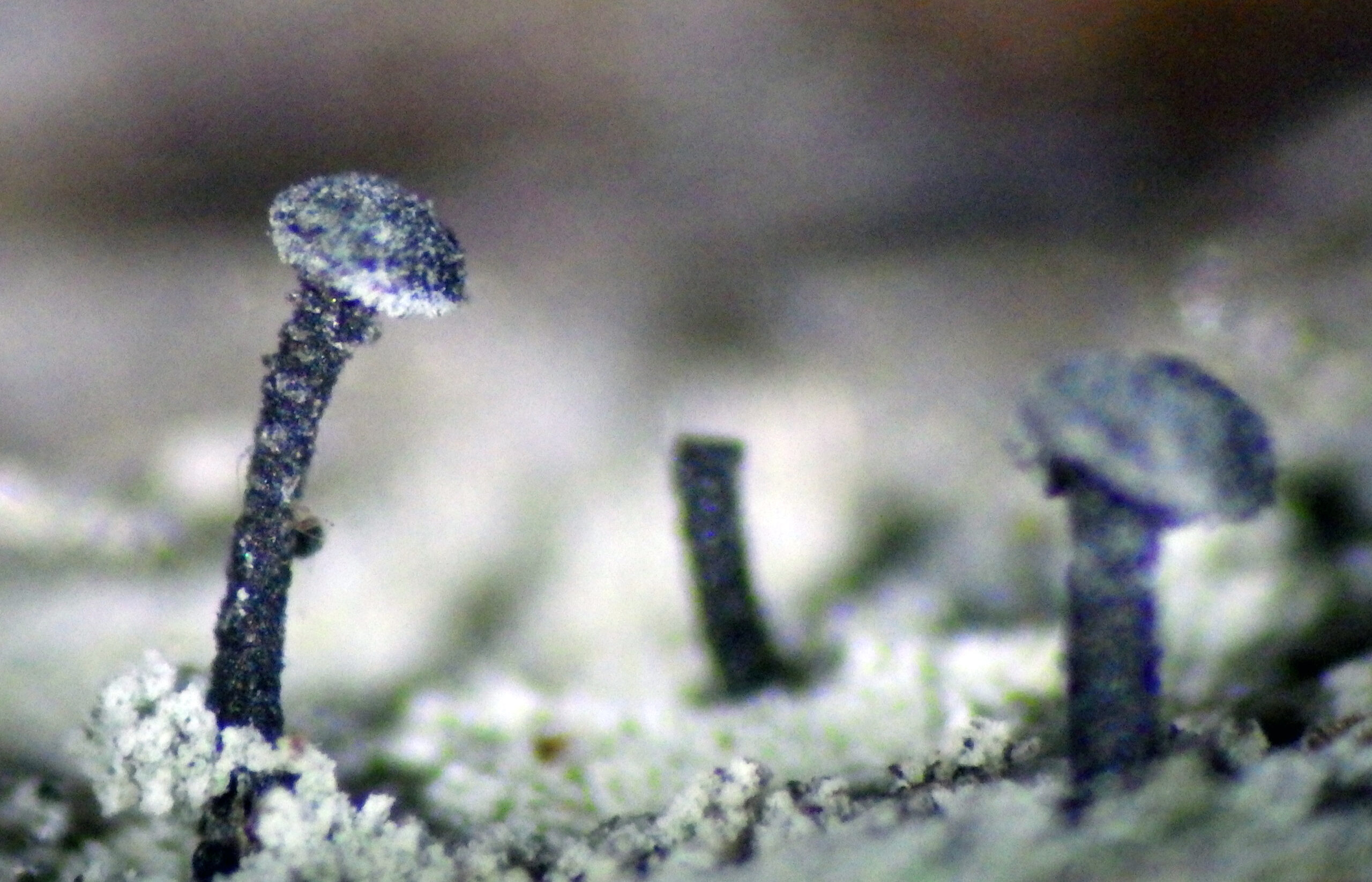
Redwood stubble (Calicium sequoiae)
is another tiny pin lichen. This one appears to be restricted to the coarse bark of old redwood (Sequoia sempervirens) trunks. Since only about 5% of old-growth redwood forest remains, the habitat for this species is very limited. It is mainly threatened by wildfires. On the IUCN red list, it is listed as endangered. Photo: Rikke Reese Næsborg. (IUCN).
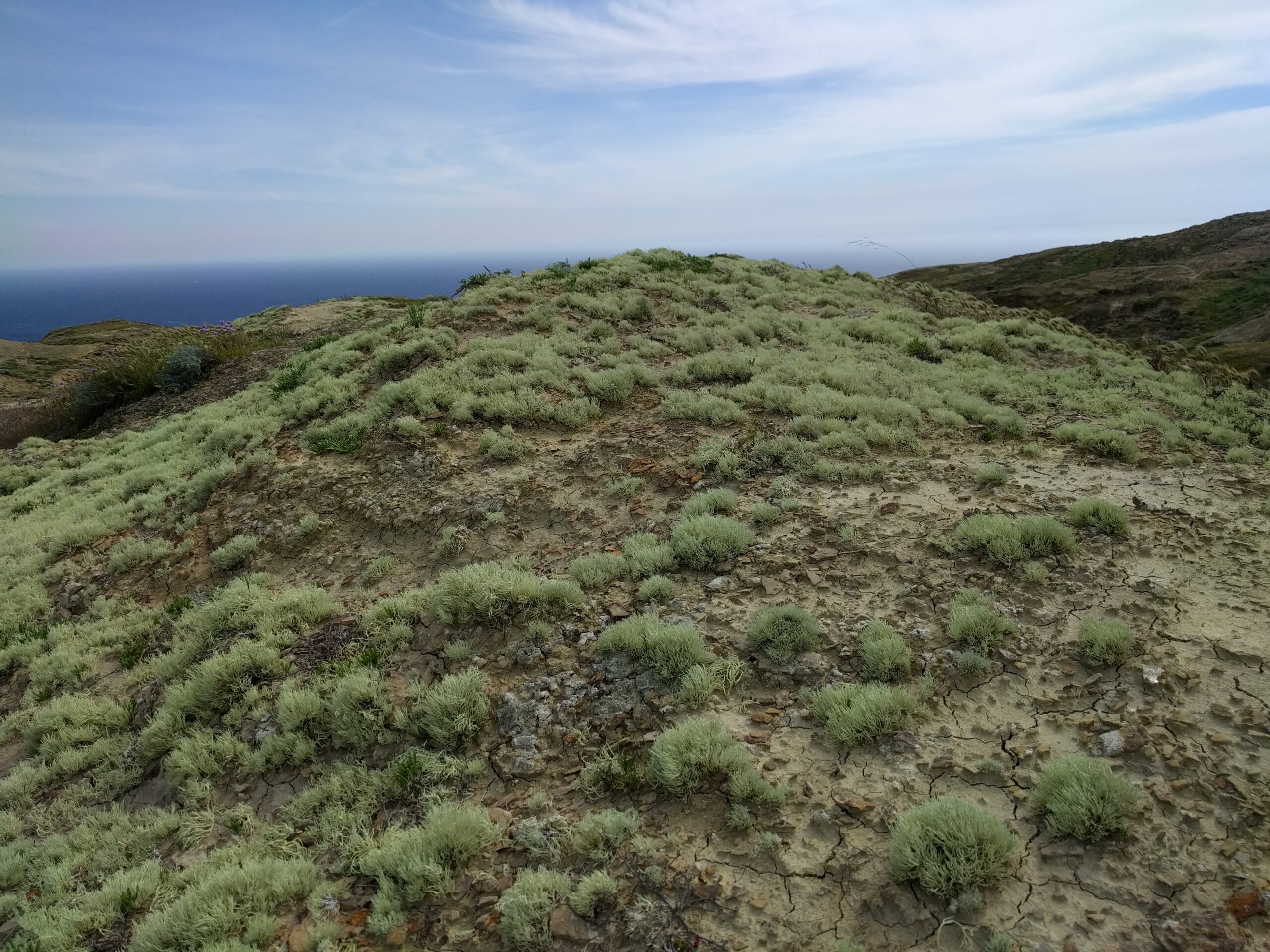
San Nicolas fog lichen (Niebla ramosissima)
is a soil-dwelling lichen that only occurs on San Nicolas Island. Here, as can be seen in the photo, it can cover large areas. Although it appears to be stable on the island, it is listed on the IUCN red list as vulnerable because a single catastrophic event on the island could render the species extinct. It is threatened by reduced fog brought on by climate change and by invasive species such as ice plant (Mesembryanthemum spp.). Photo: Rikke Reese Næsborg. (IUCN).
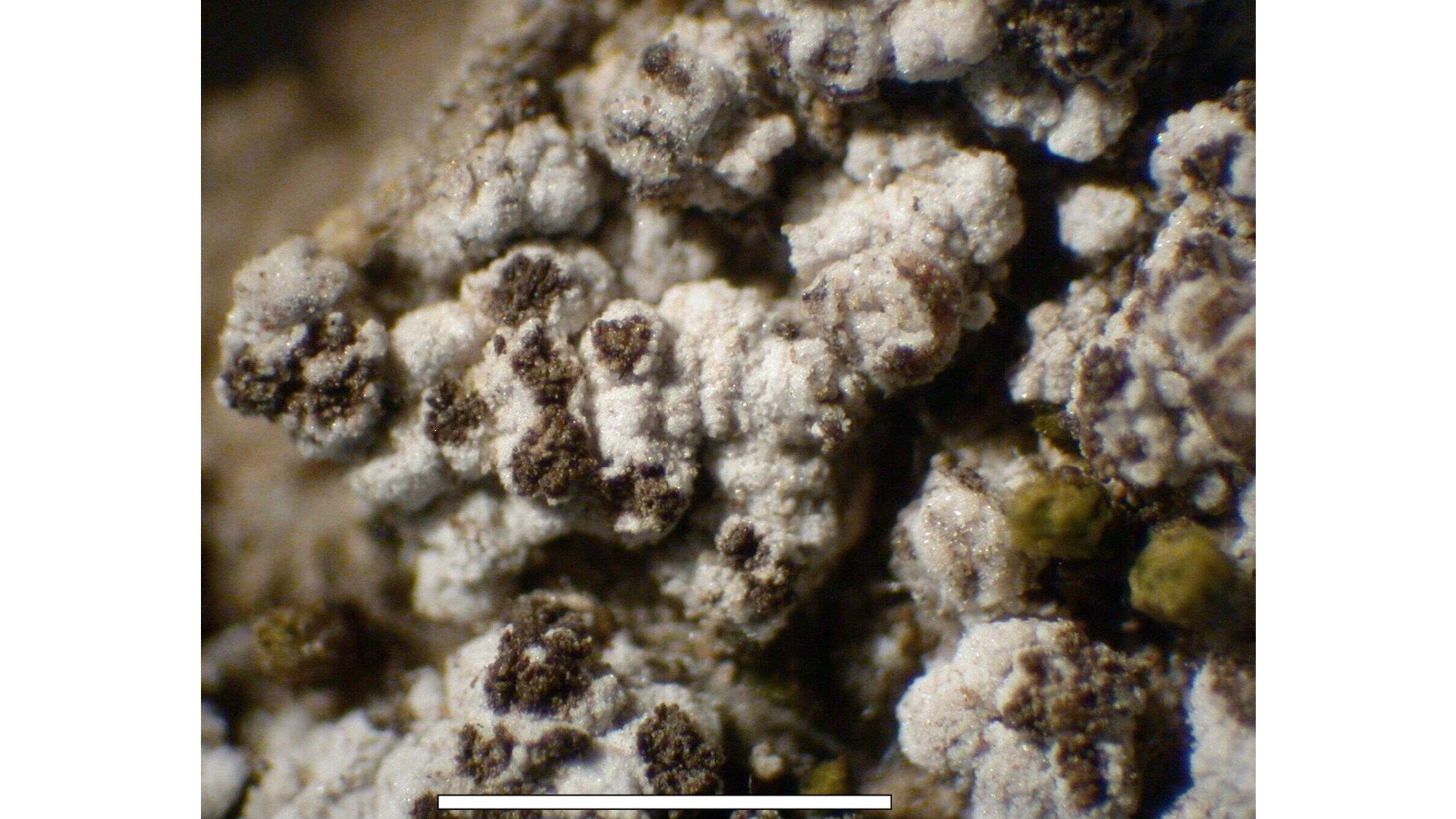
Bicolored Trapeliopsis (Trapeliopsis bisorediata)
is another soil crust species that requires undisturbed ground. In California, the species is known from 8 or 9 localities, most of which are in the southern part of the state. It is threatened by trampling, urban development, and wildfires. The IUCN red list records it as endangered. Photo: Bruce McCune. (IUCN).
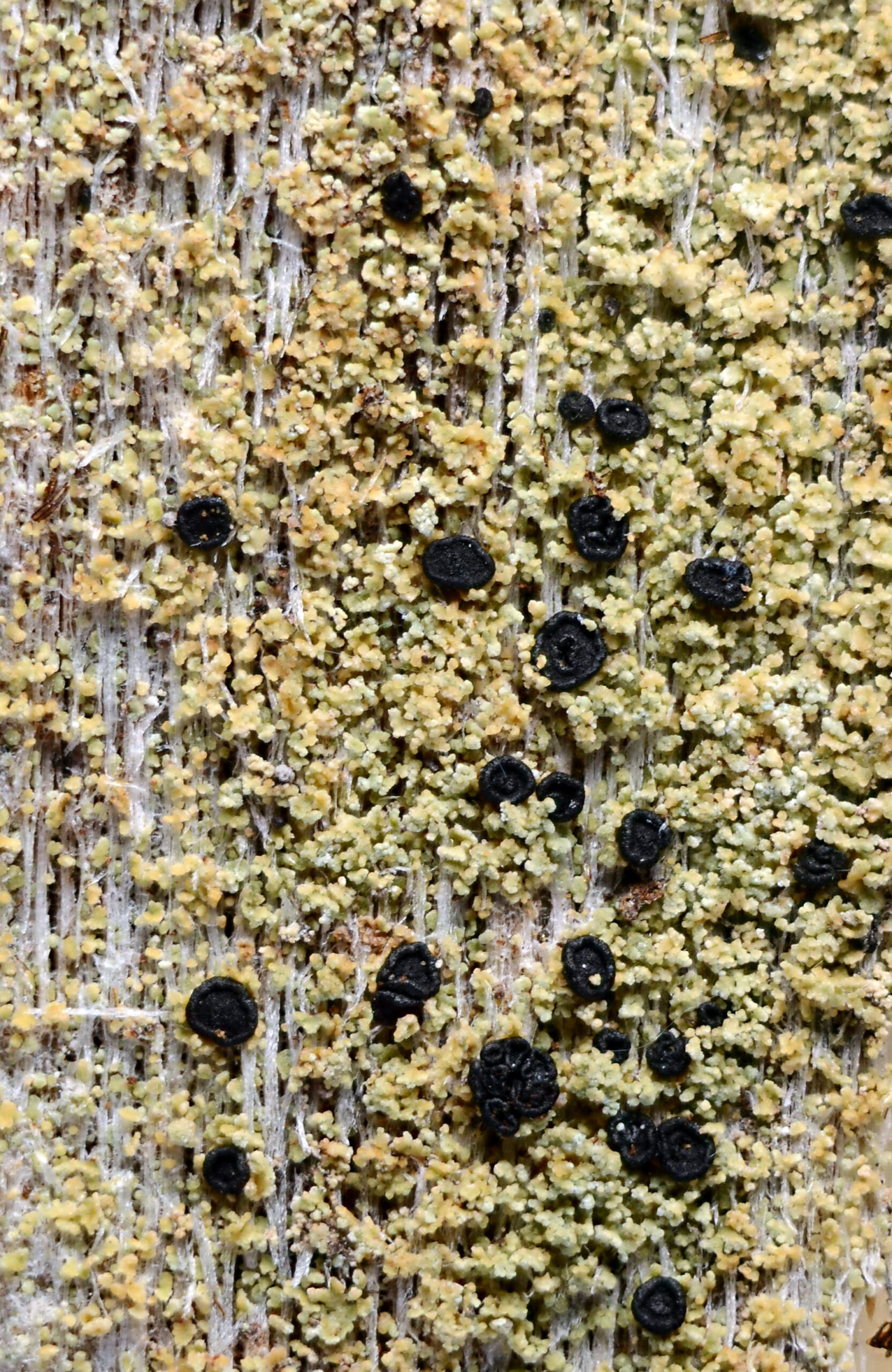
Canopy froth (Xylopsora canopeorum)
grows on the coarse bark of redwood trunks. The species is somewhat new to science after being discovered in Big Basin Redwoods State Park in 2015 and formally described in 2018. Unfortunately, in 2020 the park suffered a severe fire (CZU Lightning Complex) that burned most of its trees. Given the severity of this event, it is possible that the lichen has been extirpated from the park. Fortunately, the species is also known from two other state parks, and it may be present in other old-growth redwood forests. Wildfire remains the primary threat, and the species is listed as endangered on the IUCN red list. Photo: Einar Timdal. (IUCN).
 Donate
Donate